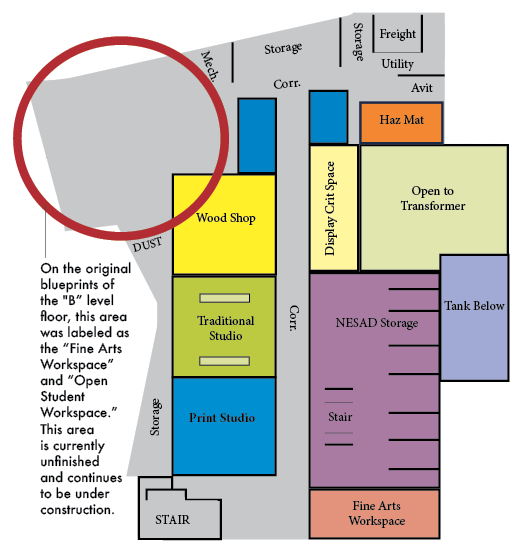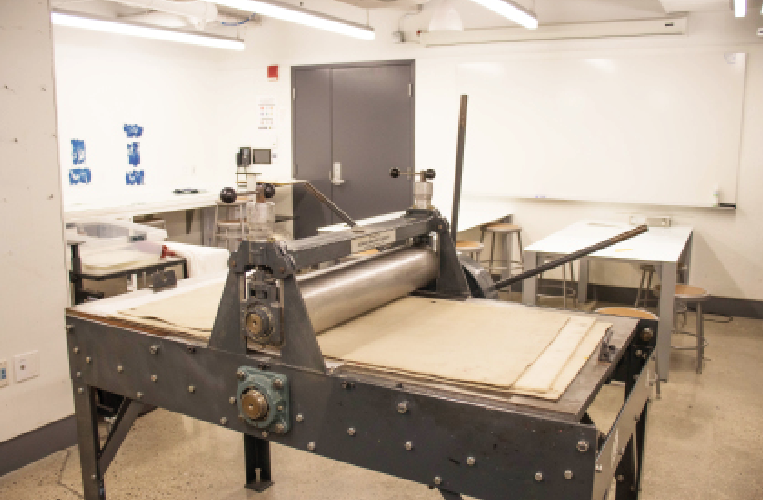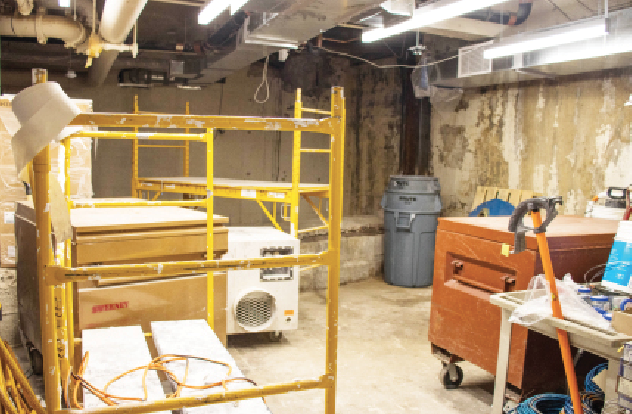Your donation will support the student journalists of Suffolk University. Your contribution will allow us to cover our annual website hosting costs.
Art & Design lose space, attempt to adjust
September 27, 2017

Alexa Gagosz/ Editor-in-Chief
As students re-matriculate throughout campus, Art and Design students are still settling into their new home on the main Suffolk campus.
In part due to the termination of the building lease, the students were granted four floors within the Sawyer building. The Art and Design Department was originally destined for the 20 Somerset building, but former Suffolk President McCarthy broke the news in 2012 that the space would instead be used for academic classrooms.
With two floors in the basement dedicated to studio and workspaces and a miniature version of their original gallery at 75 Arlington Street, the department is wriggling into its newly compressed space and learning to cope with various limitations. According to students and faculty, one of the biggest challenges has been setting up the spaces to their fullest potentials and workability.
While the move was finalized shortly after the end of the spring semester, the basement floors A and B both have classrooms and workspaces that have yet to be completed by construction, and according to a source, will not be finished for another two months. This is because of alleged water damage that occurred in two rooms on the A and B floors of the building. Faculty and students have both reported that the respective work spaces for the multiple artistic focuses within the department are still being set up, even though Foundation Studies Program Director Randal Thurston told The Journal that the move itself took two months to fully set equipment up “safely and effectively.”

Haley Clegg | Photo Editor
“Two full rooms on A and B are not complete yet because of water damage,” said Suffolk graduate and current Wood Shop Manager Jamezie Helenski in an interview with The Suffolk Journal on Thursday. According to Helenski, the damage was not substantial enough to warrant any kind of halt to construction, rather the damage delayed the progress being made on the space, furthering the wait to access the area.
While the work on the damaged space has continued to progress forward, the students occupying the area are still adjusting to the lack of work space.
“It’s been a challenge struggling for where do we go and how much space can we have,” said junior Fine Arts major Julianna Fielding. “We had very few limits on space at 75 Arlington because we had two floors and we just ran rampant and as long as we stayed within the building code, we could just put things everywhere and do art, and no one questioned it.”
According to Fielding, the fine arts students have considerably smaller studio spaces than what they are normally used to.
“We’re working through it, it’s just a matter of getting used to it and finding our space,” she said.
According to Helenski, simple tasks like setting up shop equipment proved to be more exhaustive than predicted. Tasks like running electricity to the table saw when the room didn’t have a nearby outlet close enough to plug into, or ensuring that the dust collection system ran correctly so that students could work safely and out of the way of free flowing saw dust proved to be more time consuming than what was originally planned for.
“I’ve been here since we moved. I’ve been here all summer getting things installed, servicing the equipment and making sure that it’s actually safe for people to come in the room,” said Helenski.

Haley Clegg | Photo Editor
A similar struggle rings true for graphic design majors and the lack of Macintosh computers and computer labs needed to complete assignments. According to Aditya Patel, a senior graphic design major, the new space has come equipped with mainly Windows computers, a system that doesn’t hold the same programs needed for those pursuing a career in design.
“We used to have [Macintosh computers] [in 75 Arlington] and since we are an art and design school, we rely heavily on Macs, so when I came here we had a lot of issues using Windows, and we still are,” he said.
Patel had expressed concern in an interview for new students coming into the graphic design program and told The Journal that he has not heard of any kind of assurance that more Mac computers will be installed for the graphic design students to use.
As a former fine arts student, Helenski told The Journal that they are able to sympathize with current fine arts students and the new lack of space.
According to Foundation Studies Program Director and Fine Arts Professor, Randal Thurston, the move is a welcome change because of the integration of the Art School onto the central campus. While Thurston acknowledged the lack of space and said he understands his students’ frustration with the move, he is ready to move forward with the progress that is currently underway.
“When you move into a new place and you have an institutional memory of where you came from, you have to just put that away and realize that what you actually have to work with is the space that you have,” said Thurston.